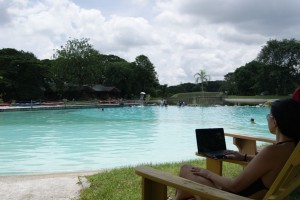Manage a restaurant: designing a menu
What is a Menu
Available Food & Beverage Items
Listed and Priced (Written, Printed or on the Board)
Aim: to transmit the right message from management to the guest. It is a Communication & Selling tools
Objectives: Menu should 1. look good, 2. easy to read & understand , 3. Reflect the Character of the operation and 4. ŌĆ£HelpŌĆØ the guest to buy more, provoke customerŌĆÖs positive reaction.
Action Plan to reach our target guest: Use the right
1. Menu Layout (size, shape, paper quality, color, typography, logo, pictures) 2. Language & Vocabulary 3. Menu items (compatibility with restaurant theme & style, available equipment, staff, space, food variety, nutritional factors, costs, guests needs) 4. Menu Structure
How to List Menus
Table dŌĆÖH├┤te Menu: List of a complete meal (3 to 8 course) for one price. This menu can be called ŌĆ£fixed priceŌĆØ or ŌĆ£meal packageŌĆØ. The guest eats a complete menu that has been planed in advance for them.
├Ć la Carte Menu: Food & Beverage items are listed and priced separately. The guest choose from various appetizers, main courses, deserts.
Combination Menu: some restaurants offers both, Table dŌĆÖH├┤te & ├Ć la Carte Menus. (Chinese Restaurants, Fast Food). The guest can compare between the meal packages with the ├Ć la Carte Menu
Menu Structure
For all Menus, Table dŌĆÖH├┤te & ├Ć la Carte, a menu should be logically divided into Group of items, or Courses, to help the guest. Based on the Classical structure, the Modern International Structure is :
Course 1. Cold Appetizers (including salads)
Course 2. Soups
Course 3. Hot Appetizers
Course 4. Fish
Course 5. Sherbet
Course 6. Main Course or Entr├®e
Course 7. Cheese
Course 8. Deserts
Important notes:
The order is important, but we can skip or ŌĆ£jumpŌĆØ one course: example 1-2-6-8 : possible, 1-3-2-7-8 : not possible
Course 1 to 3: one of them is a must
Course 5: served only for a 7 or 8 course meal
Course 6: is a must
Course 7 to 8: one of them is a must for a Table dŌĆÖH├┤te Menu
Course 7: is a must in a ├Ć la Carte Menus
Main Course Structure
The 3 parts of the Main Course should include :
1. Meat or the main “Body” of the Menu
Origin: Chicken, Duck, Turkey and Fish
Cooking method Example: Grilled
Part of : Example: Beef Fillet
Other information like sauces or butter served with. Example: served with Mushroom Sauce
2. Floury Garnish
Including cooking method: potatoes, rice or spaghetti. Example: Backed Potatoes
3. Vegetables Garnish
including cooking method or Salad (served separately) or both. Ex. Boiled Carrots
Group of items Structure (Headings)
Menu Items are grouped to help the Guest to read the Menu
A group of items should contain 5 to 9 items (Ex. Cold Appetizers)
The relation between the cheapest and most expensive food item should be at least 1-2 and maximum 1-3, in order to give the guest the choice among cheap, mid-price and expensive items. Ex. Green Salad: TL 1.950.000 (cheapest) / Ceasars Salad: TL 4.980.000 (most expensive)
In a group of item, cheapest items should be located at the beginning and the end. The most expensive item should be in the middle. The reason for this is to ŌĆ£hideŌĆØ the expensive item.
Example for Cold Apetizers:
- Green Salad : TL 1.950.000
- Sliced Tomatoes with Anchovies : TL 2.950.000
- Ceasars Salad TL : 4.980.000
- Avocado with Grapefruit : TL 3.480.000
- Spinach Salad TL : 2.480.000
Manila residents and tourists spending a vacation in Philippines prefer to travel out of town from Manila to the north to visit Subic, Pampanga, Angeles City and Clark Philippines. While many areas of the Philippines are plagued by crime and security concerns, Clark continues to impress the travel and tourism observers with its immaculately low crime records. Other features of Clark that attract family tourists and those visitors that are health sensitive include low pollution, peace and quiet ambiance and a most welcome absence of traffic congestion.
Many are selling off their assets to start a new life in Philippines, taking advantage of the standard-of-living differential to start a business or just enjoy living in a tropical country. With careful planning, the move to Philippines can work out brilliantly or it can be a painful mistake.
This web site contains articles and information that will be helpful to visitors, residents and tourists traveling out of town from Manila on a short getaway to Subic, Angeles City, Pampanga and Clark Philippines. There are several web sites that contain information that might also be pertinent to what is happening in North Luzon.
For assistance with organizing and planning weddings and garden receptions, log on to http://www.PhilippinesWeddingVenue.com
For assistance with lodgings, accommodations, hotels and resorts near Manila in Subic, Pampanga, Angels City and Clark Philippines log on to http://www.HotelClarkPhilippines.com
While in Clark, one might as well add to the itinerary a visit to the famous Clark Wine Center, the largest wine shop in Philippines which offers over 2000 selections of fine vintage wine from all wine regions, vintages spanning over 50 years covering all price ranges.
http://www.ClarkWineCenter.com
If this article about Clark is useful to you, please click here to contact us to tell us what more you wish to know about this article or Clark Philippines, which can be something about Clark investment, about Clark resorts, about Clark Swimming and Leisure or simply general news about Clark.
Please send questions to Editor@ClarkPhilippines.com. Leave your name, email address, contact numbers and we will get back to you as soon as possible. Information received will not be disclosed.













